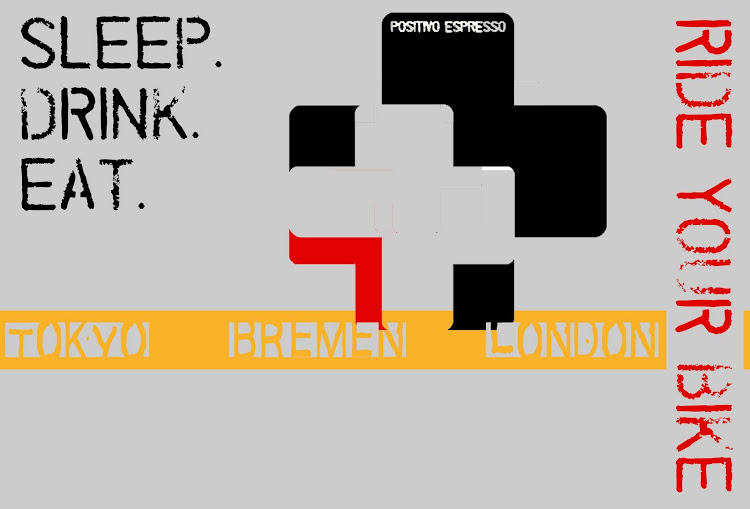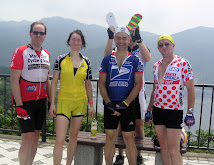 Some ideas stick in one's head forever before they are realized or finally abandoned. I wanted to travel to Chichijima for eight or nine years before I finally did it. I wanted to ride in Chiba for eight or nine days - then I called Phil and we did it.
Some ideas stick in one's head forever before they are realized or finally abandoned. I wanted to travel to Chichijima for eight or nine years before I finally did it. I wanted to ride in Chiba for eight or nine days - then I called Phil and we did it. I have to admit that I have many prejudices about Chiba. It is the prefecture which is all industry and social housing complexes in the North, followed by petrochemical plants on the coast (funny enough, the Japanese word for large petrochemical complexes is コンビナート, which comes from the (East-)German word "Kombinat", only being used in the GDR for large state-owner industrial complexes in general), followed by an endless supply of golf courses in the backyard.
I have to admit that I have many prejudices about Chiba. It is the prefecture which is all industry and social housing complexes in the North, followed by petrochemical plants on the coast (funny enough, the Japanese word for large petrochemical complexes is コンビナート, which comes from the (East-)German word "Kombinat", only being used in the GDR for large state-owner industrial complexes in general), followed by an endless supply of golf courses in the backyard.One of the biggest foreign affairs blunders of the Japanese government ever, was the decision to move the Tokyo international airport from Haneda to Narita in the Seventies. Sure enough, the developing fight of left-radicals and farmers against the construction of the airport produced many beautiful photos and videos (some can be seen at the police museum in Ginza) of beautiful aesthetics.
And in case you don't know, for the first 9 month in 2008 the number of passengers passed through Haneda airport was close to 56 million, making it by far the busiest airport in Asia, while Narita was trailing in 7th place with roughly half the pax.
So, when the average normal traveller, full of Japan and it's romantic image of Japan (Geisha, Bonsai, Samurai, Maid Cafes, Visual Kei and Anime) arrives in the morning after a long international flight in bad mood, what is he subjected to? Another endless bus or train ride into town, passing emulations of crammed, boring "mansions" and apartment blocks, warehouses in dull grey with corrugated steel roofs, production plants of unknown purpose and worse of all, Funabashi, commuter's hell.
This is the first impression one gets leaving the relatively international grounds of Narita airport and I believe that this has done more damage to the image of Japan then anything else. It's a kind of ongoing Pearl Habour publicity disaster.
So far, concerning Chiba.
But hey, one has to be open minded and I just loved the idea to ride in Chiba first, then take the ferry from Southern Boso to Miura Hanto and continue the ride on the other side of Tokyo bay. Phil from TCC, also member of the failed Tsukuba team, also member of the soon to be very successful Hitachi Naka team has kindly offered to guide me through the labyrinth of Chiba back roads.
We met at 9 at Honda station, me after a 2 hour long rain ride from Yokohama. Off we are to Lake Takataki and continue to go South on smaller roads. All the roads we ride are small and consist of a constant up and down. Riding in Chiba is definitely different from riding in the Western mountains of Tokyo. There is less climbing, the longest one is perhaps 100 to 150 m of elevation difference. So one goes anaerobic by trying to do the climbs fast and rests while doing the fast descents. It is like some kind of interval training. Phil knows the area very well with a lot of shortcuts and scenic views. Sometimes we talk while riding, but he is also a fast guy and a fast decenter so I need to concentrate to keep up with him. We concentrate of riding fast and I don't have the time to take photos.
Then suddenly the landscape opens and we have reached the cost in Southern Boso. Phil is heading back to the North and I continue along the coast road which is clogged with cars. But soon I turn to road #89 and another splendid ride through rice paddies and hills open up. I reach the coast at the end of the road and check my watch: Only 30 minutes left to reach the 14:35 ferry to Kurihama on Miura and more than 12 km to go - I need to hurry up. Luckily this coast road is not that crowded and I make good speed. The ferry is in the port and waiting for me. My bike is fixed by pros against the effects of heavy seas.
 It's now time to say good-bye to Chiba.
It's now time to say good-bye to Chiba. As I had no time to east so far, I visit the ferry's kiosk and check for some food. Hm, here they have all kind of good food on sticks: dark brown croquettes on a stick, light brown eat balls on a stick, an older mobile phone on a stick - I ask if they can warm it up for me.
As I had no time to east so far, I visit the ferry's kiosk and check for some food. Hm, here they have all kind of good food on sticks: dark brown croquettes on a stick, light brown eat balls on a stick, an older mobile phone on a stick - I ask if they can warm it up for me. After 40 minutes the ferry arrives at Kurihama. I line up in the car deck and wait for the front gate to be opened.
After 40 minutes the ferry arrives at Kurihama. I line up in the car deck and wait for the front gate to be opened. And I continue my ride in Miura, first going South along the coast, then cutting over to the West coast and heading in direction Kamakura. The pace is good, but the traffic is just terrible.
And I continue my ride in Miura, first going South along the coast, then cutting over to the West coast and heading in direction Kamakura. The pace is good, but the traffic is just terrible. For a moment I think about having coffee at the restaurant German Seacastle, but when I come close to the place I reconsider. I am just too afraid to enter the place alone. This is a restaurant as no other in Japan, a typical German restaurant where one is served unfriendly and rude and an atmosphere of fear and terror let all guest stare at their plates, silently east their meal and try to avoid to attract any attention.
For a moment I think about having coffee at the restaurant German Seacastle, but when I come close to the place I reconsider. I am just too afraid to enter the place alone. This is a restaurant as no other in Japan, a typical German restaurant where one is served unfriendly and rude and an atmosphere of fear and terror let all guest stare at their plates, silently east their meal and try to avoid to attract any attention.So I continue to Ofuna where I pack my bike again and take the train home to Shinyokohama as I really hate riding the last 20 km or so through Yokohama city.
Home the day turned out to be a mid distance ride with surprisingly lots of climbing meters. It was a good training for the forthcoming endurance events and I would like to thank Phil for his good companionship.
























































